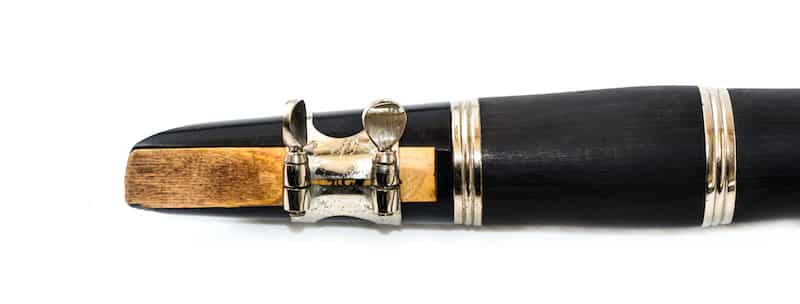It’s important to keep any instrument clean, but maintenance of the clarinet is especially vital. The best way to keep your clarinet clean is actually brushing your teeth and rinsing well before every time you play. However, this is not always doable, and even if it is, your clarinet will still need attention. Each piece requires care to keep it functioning correctly. The best time to clean a clarinet is after a practice session or rehearsal, before any residue has dried to the instrument.
In this post, we’ll walk you through everything you need to know about how to clean a clarinet with our step by step cleaning guide.
What You’ll Need
Before you start, you’ll need to get a few cleaning supplies which includes:
- Bowl
- Hot water (but not boiling)
- Sanitizing spray
- Mouthwash or hydrogen peroxide
- Clarinet swab
- Mouthpiece brush
- Cotton swab
- Dish soap/liquid hand soap
- Polishing cloth
- Cork grease
- Cleaning paper
- Key brush
- Key oil
- Bore oil
Some of these items you should have lying around the house but some are specialist cleaning items for clarinets.
You can buy them individually or you can also get a clarinet cleaning kit like this one below:
- This is a complete set, including everything you need to keep your clarinet (or most other woodwind instruments) in great shape.
- Make your life easier, and your clarinet cleaner.
- Includes also a thumb rest cushion to protect your thumb, and a reed case.
Clarinet Cleaning Step by Step Instructions
1. Take the Clarinet Apart
The first thing you need to do to before you start cleaning is to disassemble your clarinet into its five separate pieces.
You’ll also need to remove not only the mouthpiece but also take the reed and the ligature off.
As always take extra care to set them aside somewhere safe so you don’t chip your reed as they’re incredibly delicate
2. Swab the Clarinet Body
Clarinets should be swabbed out after every playing session to remove any excess moisture before you return it to its case.
It’s a very easy process but is essential to maintaining you clarinet and your own health.
A microfiber or silk swab like the one below will be fine:
- Made of high quality , specially designed microfibers
- Strong cord with easy pull-through weight
- Best humidity and grease absorption available
Take the swab and gently run it through each part of the clarinet by dropping the the weighted end of the swab through the piece and pulling it through.
Once you’ve used your clarinet swab on the body, you’ll want to take the barrel, upper joint, lower joint, and bell apart and set them aside.
Repeat this process several times until you’re satisfied there is no moisture left in the clarinet.
You can also swab your clarinet when it’s put together by flipping the clarinet so the bell is facing upwards and then taking the small, weighted end of your clarinet swab and drop it through the bell.
Which ever way you choose to do it, make sure to hold your clarinet carefully in one hand so you don’t bend any keys, use your other hand to pull on the weight and pull the swab through the instrument.
But, it’s important to never use the swab to clean the mouthpiece, as swabbing can damage them over time and change the shape of the inside of the mouthpiece.
3. Cleaning Your Reeds

Clarinet reeds need to be removed from the mouthpiece before it’s put away in its case, every single time they’re used.
If you are ill, it’s recommended that you spray your reed and mouthpiece with sanitizing spray as well.
Even if you follow these rules, your reed should still be sanitized frequently.
There are several ways to do this.
The easiest way is to soak the reed in mouthwash for 90 seconds and then rinse it under warm water.
If you don’t have mouthwash, you can also let your reed soak for several minutes in a one-to-one mixture of hot water and hydrogen peroxide and rinse thoroughly afterwards (since peroxide has a strong odor and taste).
Never use rubbing or isopropyl alcohol to sanitize a reed, as ingesting it is dangerous.
This should be sufficient to sanitize the reed.
If you play with lip balm on or have a habit of eating or drinking anything but water before you play, there may be a residue built up on the reed.
Try to to carefully scrub the reed with a fingertip in your soaking substance to eliminate any film.
Finally, let your reed dry on a flat surface to prevent warping.
4. Cleaning the Mouthpiece
The mouthpiece is often the dirtiest part of the clarinet and so you’ll need to include it in your cleaning routine.
To clean a mouthpiece well, a mouthpiece brush is the best tool to use like the one below.
- Slim brush for all woodwind mouthpieces
- Helps to clean out the cup
- Helps maintain an unobstructed air flow
Mouthpiece brushes are very inexpensive but, if you don’t have one to hand, you can try a small toothbrush or bottle brush, but be very careful of any hard surfaces on the brush that can damage the mouthpiece.
Put a few drops of plain hand soap or dish soap in a bowl and run warm water into the bowl.
But make sure it’s not boiling as if the water is too hot, it can cause the mouthpiece to warp.
Place your mouthpiece in the water and let it soak in the bowl for a few minutes.
Once it’s had some time to soak and get nice and sudsy, quickly push the mouthpiece brush in and out of the mouthpiece repeatedly to loosen any grime.
Once you’re done, rinse it well in warm water and let it dry.
A good way to test how clean the mouthpiece is is to take a cotton swab (a Q-tip) and run it along the corners on the inside of the mouthpiece.
If the cotton swab comes away clean, you’re good to go but if not, repeat the cleaning process.
When the mouthpiece is clean, make sure it dries completely before putting it back in the case.
5. Clean Each Segment
Whether you wash your hands before playing or not, your fingers will leave oil on your clarinet.
Specialty instrument polishing cloths are coated with a fine amount of polish to remove this and prevent it from collecting and won’t scratch your instrument.
If you do not have a polishing cloth, a clean microfiber cloth can work well too.
No products found.
Carefully buff the metal parts of the instrument with the cloth until they shine, paying careful attention to the keys and other places where your fingers hold the clarinet.
You can also wipe your ligature with a polishing cloth to clean that as well.
If you find rods or keys that seem to have a residue on them, it’s probably from water and excess moisture.
Condensation builds up inside the clarinet as you play, and it can leak out through the holes and drip along keys.
A dual-sided key brush (like the one in this cleaning kit) is ideal to remove this residue.
Simply take the spiralized end of the brush and gently rub it on the key until it’s clean.
For harder to reach places or joints that may just be dusty, use the end that looks like a paint brush.
6. Cleaning the Pads and Tone Holes
Condensation that doesn’t leak out builds up on the pads and tone holes of the clarinet and cause keys to stick.
To clean keypads, simply place a piece of cleaning paper between the keypad and the hole and press it several times, moving the paper each time, until the key no longer leaves a mark on the paper.
An especially sticky key may need powder paper (used in the same manner) to function properly.
7. Oiling the Keys
Key oil, like the one below, will help your clarinet’s keys move smoothly.
While most parts of the clarinet are made of metal that doesn’t rust, sometimes the screws used on those pieces will break down if stored in a high-humidity environment or frequently put away while still wet.
To lubricate and prevent rust, a drop of key oil should be placed on the hinge of each key.
A little key oil goes a long way, so use very small drops.
8. Checking the Corks
With general use, corks can dry out and become compressed and to prevent this they’ll need to be properly lubricated and preserved.
If the cork on the mouthpiece, either end of the upper joint, or the bottom of the lower joint feels dry or is difficult to slide inside its socket, rub a small smudge of cork grease (like the one below) on the tenon.
- ALL-NATURAL CORK GREASE made with high-quality ingredients
- PREVENTS CORK DRYING and cracking, extending the life of your instrument
- SMOOTH APPLICATION for easy use on cork joints, making assembly and disassembly a breeze
Use your finger to spread the grease around the whole cork but, be careful not to use too much, as it will squeeze out of the joint to places it shouldn’t be.
9. Using Bore Oil
The last step in deep cleaning a clarinet is to oil the bore (or the inside) of the instrument.
Bore oil (like the one below) protects the wood of the clarinet from absorbing too much condensation and cracking.
- Cleans and conditions Granadilla and other wooden instruments
- 100% natural organic oils. Free of lemon extracts, petroleum, and water
- Great for wooden bore instruments and any unfinished wooden parts
To do this, connect the barrel, upper joint, and lower joint and then place a small amount of oil on a clean, cotton clarinet swab.
Gently pull the swab through the instrument, and then let it sit for several minutes to absorb.
Finally, pull another clean swab through several times to collect any excess oil.
Why You Need To Clean Your Clarinet

Saliva, condensation, and even food particles build up inside the instrument when playing.
If it’s not removed, it can encourage bacteria to grow inside the moist, dark case.
On top of that, wooden clarinets require special care.
Regular cleaning can prevent buildup from tarnishing the metal, damaging the cork, ruining the pads, and cracking or splitting.
How Often to Clean Your Clarinet
Different steps of cleaning are required at different times.
The reed and mouthpiece should be sanitized as needed and always left to dry before they’re closed in the case.
You should also swab your clarinet out after every playing session.
Your mouthpiece should be brushed every other week (possibly weekly, depending on how much you play).
The ease of joint assembly will often tell you when it’s time for cork grease, but corks should be greased at least once a month.
Brushing your keys and cleaning pads should also be a monthly job.
Oiling keys and the bore should be done yearly unless you often play outside or in a very humid environment, in which case you should stick to every six months.
Summing up the Clarinet Cleaning Process
That’s it for our post on cleaning your clarinet, we hope it helped show you the ropes.
The clarinet is a beautiful but delicate instrument so in order to keep it looking great you’ll need to maintain it well and give it regular deep cleans.
Make it part of your routine to schedule in regular cleaning sessions, after all, a clean instrument is a happy instrument.







